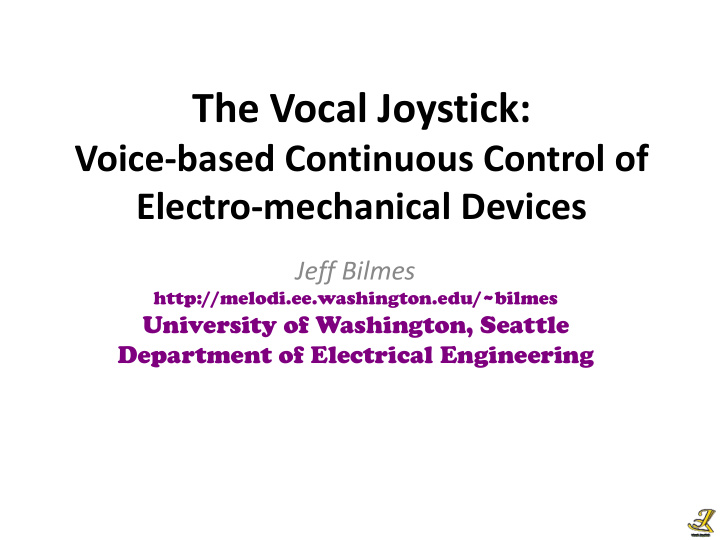



The Vocal Joystick: Voice-based Continuous Control of Electro-mechanical Devices Jeff Bilmes http://melodi.ee.washington.edu/~bilmes University of Washington, Seattle Department of Electrical Engineering
A Speech Mouse • Can you use speech to do what a mouse does? • Can you use speech to control what a joystick can control? ?? http://melodi.ee.washington.edu/v Jeff A. Bilmes j
The Vocal Joystick • The Vocal Joystick: Use the voice to produce real-time continuous control signals to control standard computing devices and robotic arms. • The analogy of a joystick: – small number of discrete commands (button presses) for simple tasks, modality switches, etc. – multiple simultaneous continuous degrees of freedom to be controlled by continuous aspects of your voice (e.g., pitch, amplitude, vowel-quality, vibrato) http://melodi.ee.washington.edu/v Jeff A. Bilmes j
Motivation • Significant population of individuals with poor (or no) motor abilities, but have good use of their voice. – Motor impairments since the time of birth – Accidents (car/bicycle accidents, sports injuries) – Veterans & war injuries • Many devices exist for their use (sip-and-puff switches (similar to Morse code), head-tracking mice, eye-tracking mice, etc.) eye-tracking mouse. head-mouse video http://melodi.ee.washington.edu/v Jeff A. Bilmes j
Issues with existing technology • Expensive, requiring special purpose hardware • Not be most efficient (leading to user frustration) • Invasive (BCI neural sensors) or noisy (BCI skull sensors) • Standard speech-recognition non-ideal for continuous control (e.g., mouse-movement, robotic limb control). Imagine: “move - left”, “move - up”, etc . • When voice-based, it might not use the full capabilities of the human voice – reduced communication bandwidth – users with (even not quite) full voice control can do more http://melodi.ee.washington.edu/v Jeff A. Bilmes j
Vocal Joystick Design Goals – easy to learn and remember (by the user) • keep cognitive load at a minimum – easy to speak (reduce vocal strain) – easy to recognize (as noise-robust and non-confusable as possible) – exploitive: use full capabilities of human vocal apparatus – universal (attempt to use vocal characteristics that minimize the chance that regional languages/dialects preclude its use) – complementary: can be used jointly with existing speech- recognition – computationally cheap: leave enough computational headroom for other important applications to run. – Infrastructure: standard hardware, microphone + computer – Infrastructure: like a library, easy to incorporate into applications. – “ Individualizable ”: can be individually configurable http://melodi.ee.washington.edu/v Jeff A. Bilmes j
Vocal Joystick Mouse: Mapping • Standard mice map physical space to physical space. • Here, we must map vocal tract articulatory change to physical space http://melodi.ee.washington.edu/v Jeff A. Bilmes j
The VJ-Mouse and VoiceBot • The VJ-mouse and VJ-VoiceBot – Research mostly concentrated on a VJ-controlled mouse (which is still quite general). – Allows us to perform a variety of tasks on a standard WIMP desktop (mouse movement and mouse clicks, and thus web browsing, slider control, some video games, Dasher typing, etc.) – VoiceBot: shows a simple voice-controlled robotic arm. http://melodi.ee.washington.edu/v Jeff A. Bilmes j
Vocal Joystick Drawing http://melodi.ee.washington.edu/v Jeff A. Bilmes j
VoiceDraw http://melodi.ee.washington.edu/v Jeff A. Bilmes j
Vocal Joystick: Toy 3D Robotic Arm http://melodi.ee.washington.edu/v Jeff A. Bilmes j
Summary and the Future 1. Voice-based human-computer interface for individuals with motor impairments. 2. Continuous aspects of the human voice to affect continuous movement in on- screen devices and simple robots 3. Long-term goal: voice-control complex robotic systems, use full vocal capabilities 1. Long-term goal: voice-control complex robotic systems, use full vocal capabilities, real-time high-dimensional continuous outputs, hyper-smart assisted control. http://melodi.ee.washington.edu/v Jeff A. Bilmes j
Recommend
More recommend